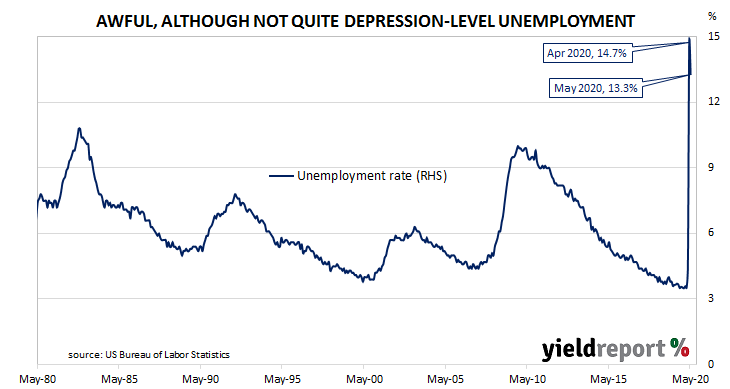Summary: May non-farm payrolls jump; increase confounds expectations; survey responses lower than normal; major bank chief economist says permanent unemployment is rising; large revisions to March, April numbers.
The US economy ceased producing jobs in net terms as infection controls began to be implemented in March. The unemployment rate had been around 3.5% but that changed in March 2020 when job losses began to surge. The latest employment report was expected to indicate further job losses but it has provided a surprise which had analysts questioning the sampling process.
According to the US Bureau of Labor Statistics, the US economy created 2.5 million jobs in the non-farm sector in May. The gain in employment was completely different from the 7.5 million fall which had been expected. Employment figures for March and April were revised down by a total of 642,000.
May’s unemployment rate eased from April’s rate of 14.7% to 13.3%. The total number of unemployed decreased by 2.093 million to 20.985 million while the total number of people who are either employed or looking for work increased by 1.746 million to 158.227 million. The increase in the number of people in the labour force raised the participation rate from April’s revised rate of 60.2% to 60.8%.
Westpac’s Finance AM team said the result “shocked” markets and it “aroused suspicions of large distortions related to COVID, the BLS pointing to those on COVID temporary unemployment not being captured and lower than normal survey responses.”

US Treasury yields increased on the day. By the close of business, the US Treasury 2-year bond yield had crept up 1bp to 0.21%, the 10-year yield had increased by 8bps to 0.90% while the 30-year yield finished 4bps higher at 1.67%.
ANZ Chief Economist Sharon Zollner said, “While it is encouraging that temporary job losses can be reversed so quickly, the data still shows 19.5 million fewer jobs in May than in February and permanent unemployment is rising.”
One figure which is indicative of the “spare capacity” of the US employment market is the employment-to-population ratio. This ratio is simply the number of people in work divided by the total US population. It hit a cyclical-low of 58.2 in October 2010 before slowly recovering to just above 61% in late-2019. May’s reading recovered a little from April’s series low of 51.3% to 52.8%.

